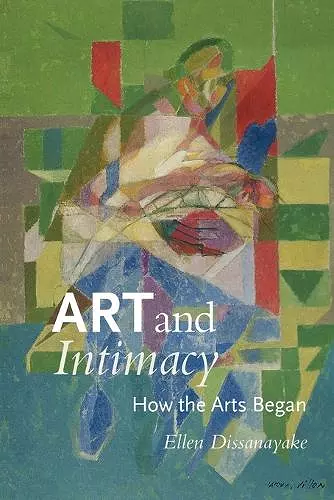Art and Intimacy
How the Arts Began
Format:Paperback
Publisher:University of Washington Press
Published:11th Apr '12
Should be back in stock very soon
This paperback is available in another edition too:
- Hardback£91.00(9780295995786)

Ellen Dissanayake has the rare gift of being able to integrate the advanced findings of a half dozen disciplines in a way that is intellectually responsible while keeping her exposition intelligible to the lay reader. Yet Art and Intimacy will also appeal to scholars working on the frontiers of aesthetics and art theory. Her focus on the psychobiological roots of human artistic practices in the mother-child bond remains a signal contribution to today's renewed interest in developing a naturalistic aesthetics. -- Larry Shiner, author of The Invention of Art: A Cultural History
Details why the arts encourage us to show that we care about important things
To Ellen Dissanayake, the arts are biologically evolved propensities of human nature: their fundamental features helped early humans adapt to their environment and reproduce themselves successfully over generations. In Art and Intimacy she argues for the joint evolutionary origin of art and intimacy, what we commonly call love.
It all begins with the human trait of birthing immature and helpless infants. To ensure that mothers find their demanding babies worth caring for, humans evolved to be lovable and to attune themselves to others from the moment of birth. The ways in which mother and infant respond to each other are rhythmically patterned vocalizations and exaggerated face and body movements that Dissanayake calls rhythms and sensory modes.
Rhythms and modes also give rise to the arts. Because humans are born predisposed to respond to and use rhythmic-modal signals, societies everywhere have elaborated them further as music, mime, dance, and display, in rituals which instill and reinforce valued cultural beliefs. Just as rhythms and modes coordinate and unify the mother-infant pair, in ceremonies they coordinate and unify members of a group.
Today we humans live in environments very different from those of our ancestors. They used ceremonies (the arts) to address matters of serious concern, such as health, prosperity, and fecundity, that affected their survival. Now we tend to dismiss the arts, to see them as superfluous, only for an elite. But if we are biologically predisposed to participate in artlike behavior, then we actually need the arts. Even -- or perhaps especially -- in our fast-paced, sophisticated modern lives, the arts encourage us to show that we care about important things.
"Ellen Dissanayake gives us a deep and even moving investigation of art’s capacity to touch every corner of our emotional lives."
-- Denis Dutton * Washington Post *"Not since Dewey's Art as Experience has there been such an impressive effort to develop a naturalist aesthetics that also takes into account the experience of transcendence."
-- Thomas Leddy * Journal of Aesthetics and Art Criticism *"Dissanayake offers an account of the origin of the arts and a cleverly argued case for a naturalist aesthetics. The premise is that 'the biological phenomena of love is originally manifested-expressed and exchanged-by means of emotionally meaningful rhythms and modes that are jointly created and sustained by mothers and their infants in ritualized, evolved interaction,' and that 'from these rudimentary and unlikely beginnings grow adult expressions of love, both sexual and generally affirmative, and the arts.'..The work draws on disciplines ranging from cultural anthropology and art history to evolutionary psychology and cognitive archaeology, with contributions from infant and developmental psychology and neuroscience..Well researched and interestingly written."
* ChoiISBN: 9780295991962
Dimensions: unknown
Weight: 386g
268 pages